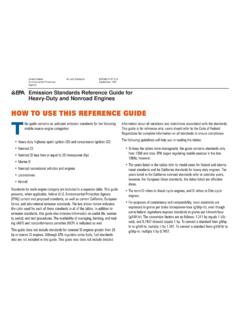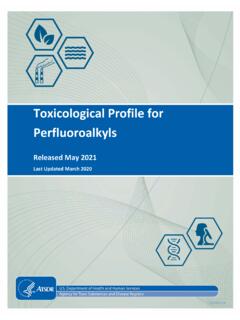Transcription of Polycyclic Aromatic Hydrocarbons - US EPA
1 1 United States Office of Solid Waste January 2008 Environmental Protection Agency Washington, DC 20460 Polycyclic Aromatic Hydrocarbons ( pahs ) What are pahs ? Short for Polycyclic Aromatic Hydrocarbons , pahs describe chemicals that are often found together in groups of two or more. pahs are found naturally in the environment but they can also be man-made. In their purest form, pahs are solid and range in appearance from colorless to white or pale yellow-green. pahs are created when products like coal, oil, gas, and garbage are burned but the burning process is not complete. Although pahs can exist in over 100 different combinations, the National Waste Minimization Program defines this group using the Toxic Release Inventory reporting category for Polycyclic Aromatic compounds.
2 Chemicals included in this category, by name and CAS number, are: 1. Benzo(a)anthracene, 56-55-3 2. Benzo(a)phenanthrene (chrysene), 218-01-9 3. Benzo(a)pyrene, 50-32-8 4. Benzo(b)fluoranthene, 205-99-2 5. Benzo(j)fluoranthene, 205-82-3 6. Benzo(k)fluoranthene, 207-08-9 7. Benzo(j,k)fluorene (fluoranthene), 206-44-0 8. Benzo(r,s,t)pentaphene, 189-55-9 9. Dibenz(a,h)acridine, 226-36-8 10. Dibenz(a,j)acridine, 224-42-0 11. Dibenzo(a,h)anthracene, 53-70-3 12. Dibenzo(a,e)fluoranthene, 5385-75-1 13. Dibenzo(a,e)pyrene, 192-65-4 14. Dibenzo(a,h)pyrene, 189-64-0 15. Dibenzo(a,l)pyrene, 191-30-0 16. 7H-Dibenzo(c,g)carbazole, 194-59-2 17. 7,12-Dimethylbenz(a)anthracene, 57-97-6 18. Indeno(1,2,3-cd)pyrene 193-39-5 19. 3-Methylcholanthrene, 56-49-5 20. 5-Methylchrysene, 3697-24-3 21.
3 1-Nitropyrene, 5522-43-0 It should be noted that some pahs are listed individually on EPA s Priority Chemical list. They are: 1. Acenaphthene, 83-32-9 2. Acenaphtylene, 208-96-8 3. Anthracene, 120-12-7 4. Benzo(g,h,i)perylene, 191-24-2 5. Fluorene, 86-73-7 6. Phenanthrene, 85-01-8 7. Pyrene, 129-00-0 Why are pahs bad actors? pahs are a concern because they are persistent. Because they do not burn very easily, they can stay in the environment for long periods of time. Individual pahs vary in behavior. Some can turn into a vapor in the air very easily. Most do not break down easily in the water. What are pahs used for? Most pahs are used to conduct research. However, some pahs are used to make dyes, plastics, and pesticides. Some are even used in medicines. How can pahs enter and leave your body?
4 One of the most common ways pahs can enter the body is through breathing contaminated air. pahs get into your lungs when you breathe them. If you live near a hazardous waste site where pahs are disposed, you are likely to breathe pahs . If you eat or drink food and water contaminated with pahs , you could be 2 exposed. Exposure to pahs can also occur if your skin contacts PAH-contaminated soil or products like heavy oils, coal tar, roofing tar, or creosote. Creosote is an oily liquid found in coal tar and is used to preserve wood. Once in your body, pahs can spread and target fat tissues. Target organs include the kidneys and liver. However, pahs will leave your body through urine and feces in a matter of days. How can you be exposed to pahs ? You can be exposed to pahs in the environment , in your home, and in the workplace.
5 Because pahs exist naturally in the environment and are man-made, you can be exposed in a number of ways. Fumes from vehicle exhaust, coal, coal tar, asphalt, wildfires, agricultural burning and hazardous waste sites are all sources of exposure. You could be exposed to pahs by breathing cigarette and tobacco smoke, eating foods grown in contaminated soil, or by eating meat or other food that you grilled. Grilling and charring food actually increases the amount of pahs in the food. If you work in a plant that makes coal tar, asphalt and aluminum, or that burns trash, you can be exposed to pahs . You can also be exposed if you work in a facility that uses petroleum or coal, or where wood, corn, and oil are burned. How can pahs affect your health? A number of pahs have caused tumors in laboratory animals that were exposed to pahs through their food, from breathing contaminated air, and when it was applied to their skin.
6 When pregnant mice ate high doses of a PAH (benzo(a)pyrene) they experienced reproductive problems. In addition, the offspring of the pregnant mice showed birth defects and a decrease in their body weight. Other effects include damage to the skin, body fluids, and the immune system. However, these effects have not been seen in humans. Is there a medical test to determine if you have been exposed to pahs ? There is a test that can measure the presence of PAH in your urine. This test can only tell you if you have been exposed; but it can t reveal how harmful the effects of the exposure will be. This test would have to be performed in a laboratory that has special equipment to detect the pahs . Another test currently being developed will be able to measure pahs in your body tissue and blood.
7 What are the medical treatments in cases of exposure? Most exposures to pahs happen every day at very low levels in the air we breathe and the foods we eat. Treatment for a short-term exposure is unlikely. Contact your doctor if you experience symptoms of pahs poisoning. What levels of exposure have resulted in harmful health effects? There is no information available from studies on humans to tell what effects can result from being exposed to individual pahs at certain levels. However, breathing pahs and skin contact seem to be associated with cancer in humans. Animal studies showed that mice exposed to 308 parts per million (ppm) of pahs (specifically benzo (a) pyrene) in food for 10 days (short term exposure) caused birth defects. Mice exposed to 923 ppm of benzo (a) pyrene in food for months caused problems in the liver and blood.
8 Where can I get more information? Contact your state health or environmental department, or: Agency for Toxic Substances and Disease Registry division of toxicology 1600 Clifton Road, , E-29 Atlanta, Georgia 30333 References 1. Agency for Toxic Substances and Disease 3 Registry (ATSDR), Public Health Statement, Polycyclic Aromatic Hydrocarbons , December 1990. Public Health Service, Department of Health and Human Services, Atlanta, GA, December 1990. 2. United States Environmental Protection Agency, Office of Environmental Information, Emergency Planning and Community Right-to-Know Act Section 313: Guidance for Reporting Toxic Chemicals: Polycyclic Aromatic Compounds Category, EPA 260-B-01-03, Washington, DC, August 2001.













